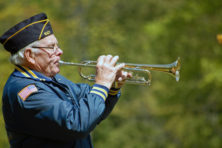The Plot Thickens and Tips, Taps or Teps?
- Share
- Tweet
- Pin
- Share
With all the hype surrounding this NFC Championship Game, it seems appropriate to turn to a subject much less serious than my previous column. Thus, I present some of my research and musings on words and phrases.
Item #1: I’m certain that no one is surprised that I have an abiding love for words. Among the many attractions that I find in language is word and phrase origins, which never fail to interest and amaze me.
With the technology we possess today it has become easier than ever to indulge this interest in word origins since there are an incredible number of sites dedicated specifically to this rather specialized interest.
The reason I mention this is that for some time I have been attempting to research the origin of the phrase “the plot thickens,” and, despite the wealth of aforementioned web sites, I have come up with…absolutely nothing. My suspicion is that this phrase originated in detective fiction, specifically (perhaps) in Sir Arthur Conan Doyle’s Sherlock Holmes stories and novels. Unfortunately, I can find nothing to either confirm or refute this supposition.
During the course of this investigation, however, I ran across a raging controversy surrounding the origins of the phrase “the whole nine yards.” Mostly, though, I was intrigued because I love a good mystery. No one – and I mean no one – can seem to agree where this phrase comes from and the best part is that the various hypotheses range across all manner of subject matter.
The two most prevalent theories involve cement mixers and machine guns. In the case of cement mixers, the theory is that ready-mix concrete trucks have a 9 cubic yard capacity. Thus, a construction crew might ask the truck driver for “the whole nine yards.” Both James Kirkpatrick and William Safire have, at various times, stumped for this theory. The facts, however, seem to rule this theory out: ready-mix trucks (according to numerous authors who have investigated this theory) normally have a capacity between 7 and 10 cubic yards, thus “nine yards” isn’t even a terribly accurate mean average.
The machine gun theory argues that 9 yards, or 27 feet, was the length of a belt of machine gun ammunition. If the gunner fired off an entire belt he was “giving the enemy the whole nine yards.” While this theory sounds good, it is almost certainly false. Among the problems are the fact that the type of machine gun varies widely depending on who is telling the story: some claim that it applied to the guns on the British Spitfire, others claim that is applied to various U. S. Navy planes in the Pacific theater of WWII, and still other’s claim that it arose in the Korean War. If any of these were true it seems virtually impossible that the phrase wouldn’t be recorded in some written record (WWII is one of the world’s most fully recorded wars), yet none exists. Those in the know on such things also point out that the 27-foot measurement for an ammunition belt is inaccurate.
As I said, these are two of the more popular theories, but the list goes on from here. Consider some of these: the length of chain attached to a cannonball; the length of chain attached to an anchor; the square footage of sail on various ships (there are innumerable, highly detailed explanations attached to this general theory); the length of material in a kilt; the length of a bridal veil (Princess Diana’s veil was between 15 and 22 feet depending on who you believe); the length of a hangman’s noose; the length of a bolt of material; number of strokes given by a “yard” (a 3’ long stick or cane) as punishment; the amount of lumber in a casket; the area of a grave; city blocks supposedly had nine houses each, so a Realtor who listed all nine houses had the whole nine yards; the amount of material in a burial shroud; the distance to your opponent in a duel before you shoot; etc., etc., etc.
Some of these sound more plausible than others, but the likelihood is that none are the correct origin since none of these theories has any written documentation to substantiate the claim. The chief problem in identifying an origin for “the whole nine yards” is that the earliest anyone has found it in print is the late 1960’s or early 1970’s (again, depending on the source), yet everyone seems to know that this phrase has been around much longer.
Nonetheless, new theories continue to crop up. I ran across a new posting this week which opines that “the whole nine yards” refers to the intestines because the length of the intestines in an average adult is approximately 27 feet! So the plot thickens. Which brings me back to my original search.
Item #2: Along the same theme is the rather interesting origin for the word “tips.” The standard meaning for this word is a gratuity paid in exchange for a service and it originated in England.
Years ago Pubs (particularly ones that served food in addition to drink) had a box mounted on the wall, often with a slot in the top, in which patrons would drop a few coins. These boxes were labeled “To Insure Prompt Service,” which, when transformed into an acronym, becomes “tips.”
The curious aspect of this origin is that, in proper English, the word “insure” is misused. The more appropriate words would be “assure” or “ensure,” with the latter being the better choice. Most of the patrons of English pubs in the 17th century, however, probably weren’t speaking the King’s English (and most probably couldn’t write, anyway), so they can be forgiven. Besides, “taps” or “teps” just doesn’t seem to sound right.


